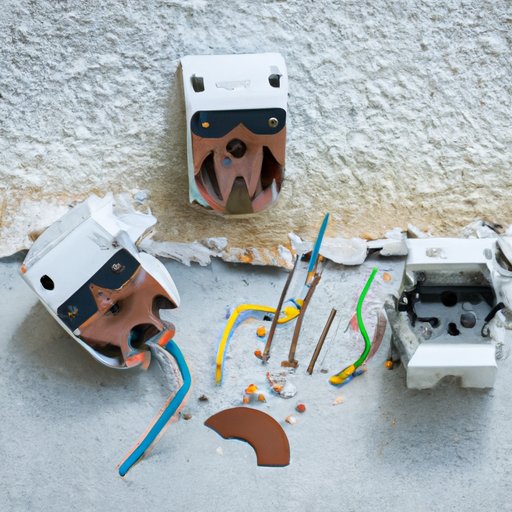Exploring the Basics: How Does a GFI Work?
A ground fault interrupter (GFI) is an electrical safety device designed to protect people from electric shock by quickly cutting off power to a circuit when a ground fault or short circuit is detected. GFIs are typically found in homes, offices, and other locations where electricity is used. Understanding how a GFI works is important for anyone who uses electricity in their daily lives.
Definition of Ground Fault Interrupter
A ground fault interrupter, commonly known as a GFI, is a device that monitors the flow of electricity in a circuit. If it detects a sudden change in the flow of electricity, such as a short circuit or ground fault, the GFI will cut off power to the circuit. This helps prevent shocks and fires from occurring due to improper wiring or faulty appliances.
How a GFI Works
When a GFI is installed in a circuit, it constantly monitors for any changes in the current flowing through the circuit. If a ground fault or short circuit occurs, the GFI will detect the difference in current and immediately shut off power to the circuit. This helps protect against electric shock, fire, and other hazards caused by faulty wiring or malfunctioning appliances.
What Types of Electrical Circuits Need GFI Protection
GFI protection is typically required in areas where water or moisture may be present, such as bathrooms, kitchens, garages, and outdoor outlets. According to the National Fire Protection Association (NFPA), all outlets located within six feet of a sink, bathtub, or other water source should be protected with a GFI. Additionally, all outdoor outlets must be GFI-protected.
A Step-by-Step Guide to Understanding GFI Technology
In order to understand how a GFI works and how to install one, it’s important to have a basic understanding of the components of a GFI system and the voltage and current requirements for proper operation. Here’s a step-by-step guide to understanding GFI technology.
Examining the Components of a GFI System
A GFI system consists of three main components: the GFI outlet, the circuit breaker, and the wiring. The GFI outlet is the visible part of the system and is designed to detect changes in current. The circuit breaker is responsible for controlling the flow of electricity and cutting off power to the circuit if a fault is detected. The wiring connects the GFI outlet and the circuit breaker, allowing them to communicate and work together.
Understanding Voltage and Current Requirements for GFI Operation
In order for a GFI to operate properly, the voltage and current must meet certain requirements. The voltage must be between 110 and 120 volts in order for the GFI to detect changes in current. Additionally, the current must be 5 milliamps or less in order for the GFI to trip and shut off power to the circuit.
Learn How to Test a GFI and Install/Replace GFI Outlets
Testing and replacing a GFI outlet is a relatively simple process. To test a GFI, press the “test” button on the outlet. If the GFI trips, then it is working correctly. If it does not trip, then it needs to be replaced. To replace a GFI outlet, turn off the power to the circuit and disconnect the wiring. Then, install the new GFI outlet and reattach the wiring. Finally, turn the power back on and test the new GFI.

From Outlets to Breakers: What You Need to Know About GFI Operation
In addition to understanding the components of a GFI system, it’s important to know how GFI outlets differ from standard outlets and the role of circuit breakers and GFI outlets in home wiring. Here’s what you need to know about GFI operation.
How GFI Outlets Differ from Standard Outlets
GFI outlets are different from standard outlets in that they have a built-in circuit breaker. This allows the GFI to detect changes in current and shut off power to the circuit if necessary. Standard outlets do not have this feature, so they cannot provide the same level of protection as a GFI.
The Role of Circuit Breakers and GFI Outlets in Home Wiring
Circuit breakers are responsible for controlling the flow of electricity in a home. They are connected to the main power source and can be used to shut off power to a particular circuit if a fault is detected. GFI outlets are connected to the circuit breakers and act as additional layers of protection against electric shock and fire.
Troubleshooting Common Problems With GFI Operation
If a GFI outlet is not working properly, there could be several possible causes. Some of the most common issues include tripping too often, not tripping when it should, or not resetting after it trips. To troubleshoot these problems, check the wiring, test the GFI, and make sure the voltage and current requirements are being met. If the problem persists, contact a professional electrician.

The Benefits and Drawbacks of Installing a GFI in Your Home
Installing a GFI in your home can provide an extra layer of protection against electric shock and fire. However, there are both advantages and disadvantages to installing a GFI. Here’s what you need to know about the benefits and drawbacks of installing a GFI in your home.
Advantages of Installing a GFI
One of the main benefits of installing a GFI is that it provides an extra layer of protection against electric shock and fire. GFIs are designed to detect changes in current and shut off power to the circuit if necessary, helping to prevent accidents and damage to property. Additionally, GFIs are relatively inexpensive and easy to install.
Disadvantages of Installing a GFI
One of the drawbacks of installing a GFI is that it can be prone to false alarms. If the GFI is not installed properly or the voltage and current requirements are not met, it can cause the GFI to trip unnecessarily. Additionally, GFIs may require regular testing and maintenance to ensure they are functioning properly.

GFI Installation and Maintenance Tips for Homeowners
Installing a GFI in your home is a relatively simple process, but it’s important to take the necessary precautions to ensure it is installed properly and functioning correctly. Here are some tips for GFI installation and maintenance.
Hiring an Electrician to Install a GFI
If you are not comfortable installing a GFI yourself, it’s best to hire an electrician. An electrician can ensure the GFI is installed properly and that the voltage and current requirements are being met. This helps prevent false alarms and ensure the GFI is providing the maximum amount of protection.
DIY GFI Installation Tips
If you choose to install a GFI yourself, it’s important to take the necessary precautions. Make sure the power is turned off before beginning the installation and always follow the manufacturer’s instructions. Additionally, make sure the wiring is connected properly and the voltage and current requirements are being met.
Regularly Testing and Maintaining Your GFI
Once a GFI is installed, it’s important to test it regularly and make sure it is working properly. To test a GFI, press the “test” button on the outlet. If the GFI trips, then it is working correctly. If it does not trip, then it needs to be replaced. Additionally, it’s important to regularly inspect the wiring and make sure it is secure and in good condition.
Troubleshooting Common GFI Issues: What to Do When Things Go Wrong
If you encounter any issues with your GFI, it’s important to identify the problem and take the necessary steps to fix it. Here’s what you need to know about troubleshooting common GFI issues.
Identifying Common GFI Problems
Some of the most common issues with GFIs include tripping too often, not tripping when it should, or not resetting after it trips. Other common issues include loose wiring, poor connections, and incorrect voltage or current requirements.
Troubleshooting Solutions for Common GFI Issues
To troubleshoot GFI issues, start by checking the wiring and making sure the connections are secure. Additionally, make sure the voltage and current requirements are being met. If the issue persists, try resetting the GFI by pressing the “reset” button on the outlet. If the problem still persists, contact a professional electrician.
Contacting a Professional Electrician When Necessary
If you are unable to identify or resolve the issue on your own, it’s best to contact a professional electrician. An electrician can inspect the GFI and wiring to identify the issue and take the necessary steps to fix it. This helps ensure the GFI is providing the maximum amount of protection.
Conclusion
Ground fault interrupters (GFIs) are an important part of any home wiring system. Understanding how a GFI works and how to install and maintain one is essential for anyone who uses electricity in their daily lives. By following the steps outlined in this article, you can help ensure your GFI is providing the maximum amount of protection.
(Note: Is this article not meeting your expectations? Do you have knowledge or insights to share? Unlock new opportunities and expand your reach by joining our authors team. Click Registration to join us and share your expertise with our readers.)
